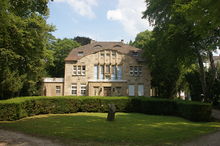Franz Brantzky
Franz Brantzky (born January 19, 1871 in Cologne , † April 28, 1945 in Dinkelsbühl ) was a German architect , sculptor and painter .
Life
Brantzky completed an apprenticeship in decorative painting, modeling and chasing at the commercial technical schools in Cologne and worked from 1888 in the studio of the architect Georg Eberlein . From 1896 he was a freelance architect and achieved numerous competition successes, for example for his design for the Bergschule Bochum . From 1902 he studied at the Academy of Fine Arts in Munich under Franz von Stuck and in the same year opened his “Atelier for Artistic Architecture and Execution”. From 1904 he worked again in Cologne and designed as an architect monuments, villas and the dam wall of the Möhne reservoir , at that time the largest barrier wall in Europe, and in 1908 the extension to the arts and crafts museum for the then new Schnütgen Museum . Brantzky took part in the First World War as a soldier . When he died in 1945, he was utterly impoverished.
Architect in the Cologne Carnival
Brantzky designed numerous carnival floats for the Cologne Rose Monday procession in the 1920s and 1930s . During the time of National Socialism, there were also those who dealt critically with Nazi officials. However, he later used anti-Semitic motifs for his cars. The Cologne Carnival Festival Committee commissioned him in 1936 and 1937 with the overall construction management of the Rose Monday procession.
Buildings and designs (selection)
- 1896: Competition design, executed 1897–1898: Bergschule in Bochum , Herner Straße 45
- 1896: Competition design, executed 1897–1899: Kunstgewerbemuseum in Cologne on Hansaplatz
- 1898: Competition design, execution 1898–1900: Office building of the Chamber of Commerce and Industry in Reichenberg in Bohemia
- 1901–1903: Villa Bungarten in Bonn , Adenauerallee 89a
- 1905: Exhibition building for the Cologne 1905 craft and applied arts exhibition
- 1906: House at Rolandstrasse 70 in Cologne-South
- 1907: Competition design for the house of the sculptor Josef Moest in Cologne-Heumar (1st prize)
- 1908: Tomb for the Ferdinand Fera family in the Ohlsdorf cemetery in Hamburg
- 1908: competition design, execution until 1913: design of the dam and the buildings of the Möhne reservoir (1st prize)
- 1908–1909: House for Hugo Knops, called " Villa Lucia ", in Bad Breisig
- 1908–1910: Schnütgen Museum in Cologne, Hansaring 32a
- 1909: Competition design for the arts and crafts school in Cologne (1st prize)
- 1908 design, executed 1909–1910: Villa for Dr. Wilhelm Kolvenbach in ( Cologne -) Rodenkirchen , Kirchstrasse 13
- 1910: Competition design for a Bismarck monument in Uerdingen (1st prize)
- 1910: three competition designs for a Bismarck national monument on the Elisenhöhe near Bingerbrück (one design was awarded one of two 2nd prizes; two designs were not awarded)
- 1910: Interior design of the Protestant Christ Church in Velbert (building by architect Carl Krieger)
- 1910: Museum for East Asian Art in Cologne
- 1910–1915: Römerbrunnen in Cologne
- 1914: Draft for a memorial with an equestrian statue of Kaiser Wilhelm I in Neuss (not executed)
- 1919: Gravestone for the racing cyclist Peter Günther in Cologne's southern cemetery (inauguration at the end of November 1919)
- 1926: Competition design, executed by 1931: War memorial 1914–18 with a sculpture of a wounded lion in Sinzig
- 1927: Competition design for a hero painting in Andernach (1st prize)
- 1933: Memorial for the Cologne SA man Walter Spangenberg at the Melatenfriedhof in Cologne
- 1933/1934: Design of a national monument on the Hammersteiner Werth
Awards
- 1905: Golden Medal of the City of Cologne
- 1909: International Art Prize Munich
- 1928: Honorary membership of the Düsseldorf Art Academy
Fonts
- Travel sketches , Berlin: Kanter & Mohr 1898.
- Architecture: 60 plates in autotype, line etching and original etching, Cologne: Karl Geerling Verlag 1906 ( digitized ).
- together with Fritz Bräuning and Georg R. Risse: The competition for the architectural training of the Möhnetalsperre . In: Zentralblatt der Bauverwaltung, 1908, pp. 61–65.
- Model of the Evangelical Church for Velbert. In: Moderne Baufformen, 1909, p. 398.
- The Roman fountain in Cöln a. Rh. In: Moderne Baufformen, 1916, pp. 18–20.
literature
- Käthe Menne-Thomé: Franz Brantzky (1871–1945). A Cologne architect in his time. Dissertation, University of Cologne, 1980.
Web links
- Literature by and about Franz Brantzky in the catalog of the German National Library
- Works by Franz Brantzky in the digital collections of the Stuttgart University Library
- Proof and description of holdings 1020 (Franz Brantzky estate) in the Historical Archive of the City of Cologne on the Archive in NRW website , last accessed on August 15, 2011
- Entry on Franz Brantzky in the register book 1884-1920 of the Academy of Fine Arts , last accessed on August 15, 2011
Individual evidence
- ↑ Obchodní a živnostenská komora on liberec-reichenberg.net (Czech), accessed on December 16, 2018
- ↑ Max Schmid (ed.): One hundred designs from the competition for the Bismarck National Monument on the Elisenhöhe near Bingerbrück-Bingen. Düsseldorfer Verlagsanstalt, Düsseldorf 1911. (n. Pag.)
- ↑ Kölner Stadt-Anzeiger from December 1, 1919
- ^ Renate Franz : Peter Günther. In: rheinische-geschichte.lvr.de. April 11, 2016, accessed June 27, 2016 .
- ^ Fritz Bilz, Ulrich Eumann: The Winterberg-Spangenberg case and the struggle for interpretive sovereignty. In: Yearbook of the Cologne History Association , Volume 79 (2008), pp. 139–175. ( online as PDF)
| personal data | |
|---|---|
| SURNAME | Brantzky, Franz |
| BRIEF DESCRIPTION | German architect, sculptor and painter |
| DATE OF BIRTH | January 19, 1871 |
| PLACE OF BIRTH | Cologne |
| DATE OF DEATH | April 28, 1945 |
| Place of death | Dinkelsbühl |


